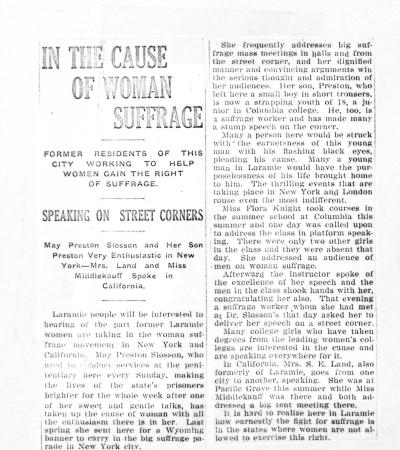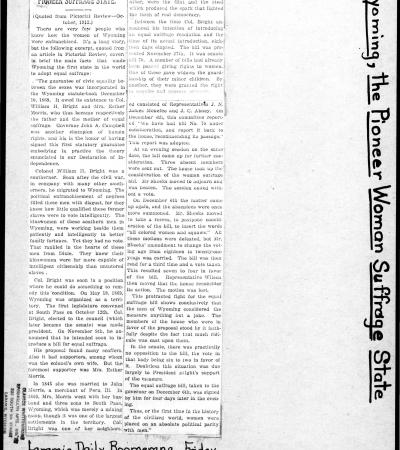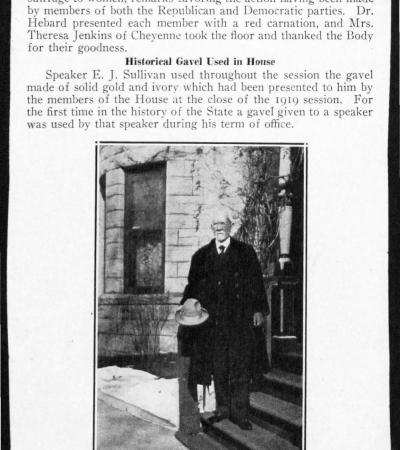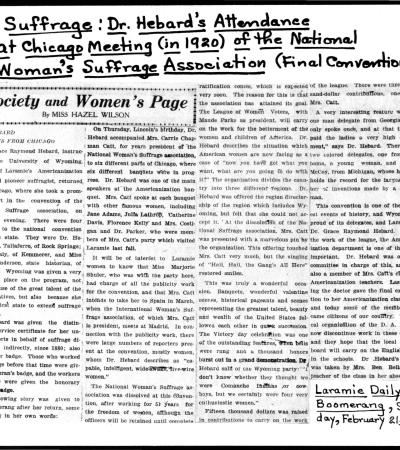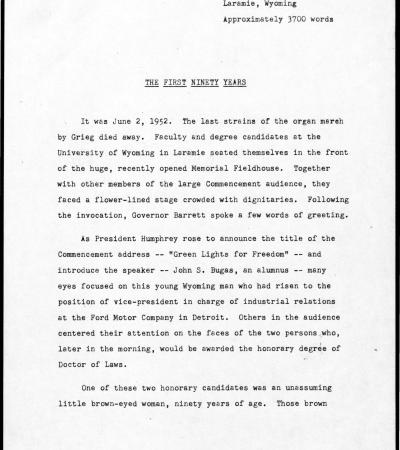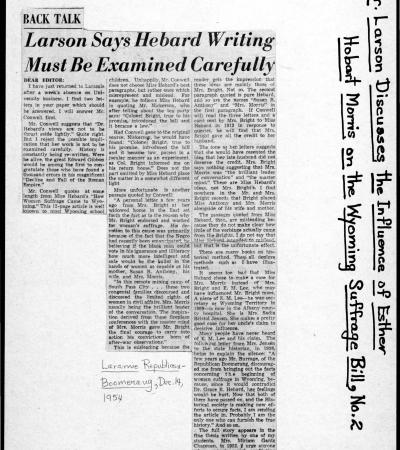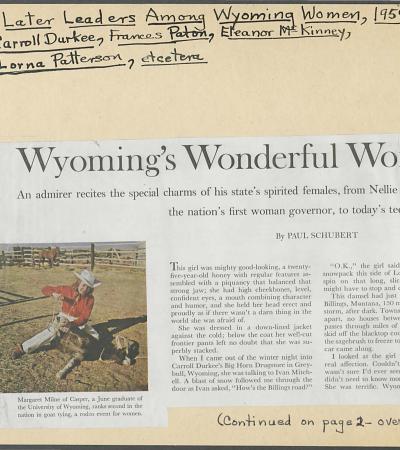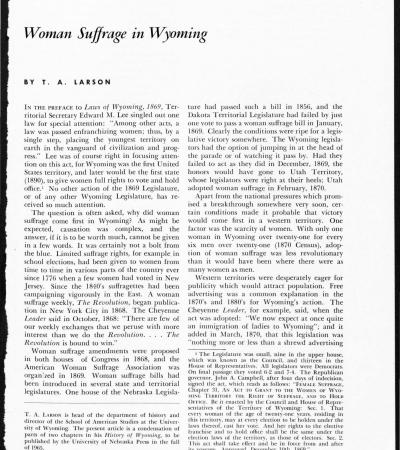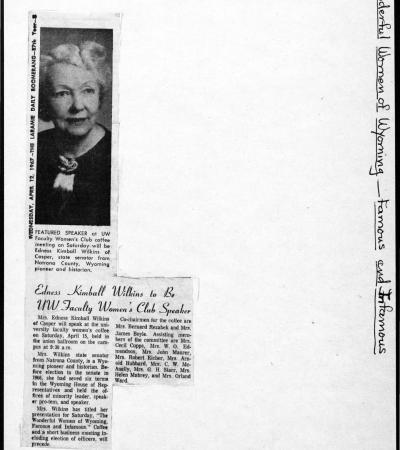Clarice T. Whittenburg was born in Missouri in 1899. She taught in Missouri public schools until 1930, when she moved to Laramie, Wyoming, where she taught at the University of Wyoming Laboratory School for 11 years. She was a professor of elementary education at the University of Wyoming until her retirement in 1964. Whittenburg also did a great deal of historical research (particularly on Wyoming and the West) and wrote a fourth grade textbook titled Wyoming's People. Whittenburg died in 1971.
"In the Cause of Woman Suffrage" in Laramie Daily Boomerage, 28 Septemeber 1911
May Preston Slosson was the first woman to obtain a doctorate in philosophy in the United States from Cornell University. Her thesis being about the Different Theories of Beauty. After moving to Wyoming with her husband she started her family. May, her husband, and her son Preston William Slosson were strong suffragists and marched in New York City. Flora Knight was a student at the University of Wyoming, but both Knight and Mrs. Scott E.
"Wyoming, the Pioneer Woman Suffrage State" in Laramie Daily Boomerang, 3 October 1913
Colonel William H. Bright was born in Virginia, fought for the Union during the Civil War, and was a saloonkeeper in a small town near Cheyenne. Bright was the individual who introduced the bill that would give women the right to vote in Wyoming. Bright was voted as the President of the Council for the First Legislature. Many individuals on the council had the thought that if Black and Chinese men would have the right to vote then white women should also have that right to vote, Bright agreed with this argument.
Exerpt from "Wyoming Historical Collection" regarding the ratification fo national woman suffrage amendment
On January 26th 1920, the Wyoming Senate voted unanimously to ratify the 19th amendment. Eleven women attended the legislative sessions and were recognized for thier work for women's suffrage. On August 26th 1920, the 19th amendment was ratified after Tennessee voted in its favor. Edward Ivinson was the Mayor of Laramie, Wyoming having had made his fortune from a banking career. Ivinson later in his life donated vast amounts of money leaving a strong legacy. One of the lasting legacies is the Ivinson Memorial Hospital and his support for the women right's movement.
"Dr. Hebard: Returns from Chicago" by Miss Hazel Wilson in Laramie Daily Boomerang, 21 February 1920.
Dr. Grace Hebard was a professor at the University of Wyoming and served as the first female on the University of Wyoming Board of Trustees. Dr. Hebard was the first woman admitted to the Wyoming State Bar Association in 1898, practiced before the Wyoming Supreme Court in 1914, and was the vice president of the National Society of Women Lawyers. Dr.
"The First Ninety Years" by Clarice Whittenburg
Mary Godat Bellamy was the first woman to be elected to the Wyoming Legislature, serving in the House of Representatives for a single term starting in 1910. Before joining the legislature she ran for County Superintendent of schools in territorial Albany County in 1888. She supported changes in Wyoming law that allowed women to serve as administrators and executors. She was an active member of the Council of Women Voters.
"Larson Says Hebard Writing Must Be Examined Carefully" in Laramie Republican -Boomerang, 14 December 1954
Dr. Grace Hebard was a respected historian throughout her lifetime. She wrote many books, articles and pamphlets discussing topics that were pressed during her era. She was a professor of politics and history at the University of Wyoming. T.A. Larson was a Wyoming historian, Yellowstone employee and had a progressive outlook.
"Wyoming's Wonderful Women; an admirer recites the special charms of his state's spirited females, from Nellie Tayloe Ross, and the nation's first woman governor, to today's teen-age cuties" by Paul Schubert in The Saturday Evening Post, 1 August 1959
Not only were there strong female leaders during the beginning of the women's suffrage movement, the strong female leaders in Wyoming stayed until the end. Wyoming in 1869 passed a bill declaring that every women the age of 21 or older was able to cast her vote. In the first murder trial the jury consisted of 6 men and 6 women. Eliza Stewart was the only single woman to serve on the jury. Nellie Tayloe Ross was the nation's first woman governor.
"Woman Suffrage in Wyoming" by T.A. Larson
The Wyoming territories needed publicity in hopes to attract population, an immigration of people coming to live in the territories. There were many people who played large roles in women suffrage, some passing through Wyoming and some callling Wyoming home, never the less the lasting impact made by these individuals was remarkable and continues to be seen nearly 150 years later.
"Edness Kimball Wilkins to Be UW Faculty Women's Club Speaker" in Laramie Daily Boomerang, 12 April, 1967.
Edness Kimball Wilkins was the first female Speaker of the Wyoming House of Representatives. She served a total of six terms in the state legislature. Having been passed over originally for Speaker of the House, stating that she was used to stepping aside for men.
